FERTILIZING 101
Feed Sooner, Not later
Although shoot growth of woody plants ground to a halt weeks ago, root growth will continue until soil temperatures drop below about 40 degrees Fahrenheit. Root and shoot growth of woody plants and lawn grass are asynchronous, with root growth at a maximum in early spring and fall, and shoot growth at a maximum in summer. So roots aren’t just barely growing this time of year; they’re growing more vigorously than in midsummer.
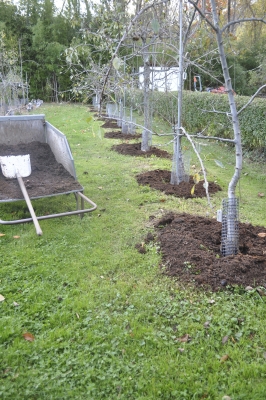 Remember the song lyrics: “House built on a weak foundation will not stand, no, no”? Well, the same goes for plants. (Plant with a weak root system will not be healthy, no, no.) Fertilization in the fall, rather than in winter, spring, or summer, promotes strong root systems in plants.
Remember the song lyrics: “House built on a weak foundation will not stand, no, no”? Well, the same goes for plants. (Plant with a weak root system will not be healthy, no, no.) Fertilization in the fall, rather than in winter, spring, or summer, promotes strong root systems in plants.
By the time a fertilizer applied in late winter or early spring gets into a plant, shoots are building up steam and need to be fed. Fertilization in summer forces succulent shoot growth late in the season, and this type of growth is susceptible to damage from ensuing cold.
They Hunger For . . .
The nutrient plants are most hungry for is nitrogen. But nitrogen is also the most evanescent of nutrients in the soil, subject to leaching down through the soil by rainwater or floating off into the air as a gas. The goal is to apply nitrogen so that it can be taken up by plants in the fall, with some left over to remain in the soil through winter and be in place for plant use next spring.
Two conditions foster nitrogen loss as gas. The first is a waterlogged soil. If you’re growing most cultivated plants — yellow flag iris, marsh marigold, rice, and cranberry are some exceptions — your soil should not be waterlogged, aside from considerations about nitrogen. (Roots need to breathe in order to function.) Nitrogen also evaporates from manure that is left exposed to sun and wind on top of the soil. Manure either should be dug into the soil right after spreading, or composted, after which it can be spread on top of the soil, or dug in.
Leaching of nitrogen fertilizer is a more common and serious problem, especially on sandy soils. The way to prevent leaching is to apply a form of nitrogen that either is not readily soluble, or that clings to the soil particles. Most chemical fertilizers — whether from a bag of 10-10-10, 5-10-10, or any other formulation — are soluble, although a few are specially formulated to release nitrogen slowly.
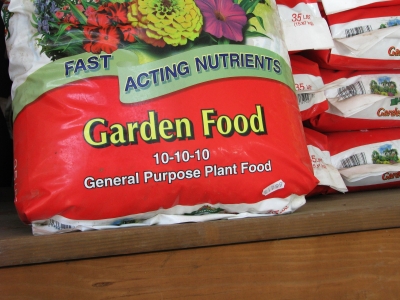 The two major forms of soluble nitrogen that plants can “eat” are nitrate nitrogen and ammonium nitrogen. Nitrate nitrogen will wash right through the soil; ammonium nitrogen, because it has a positive charge, can be grabbed and held onto negatively charged soil particles. Therefore, if you’re going to purchase a chemical fertilizer to apply in the fall, always buy a type that is high in ammonium nitrogen. The forms of nitrogen in a fertilizer bag are spelled out right on its label.
The two major forms of soluble nitrogen that plants can “eat” are nitrate nitrogen and ammonium nitrogen. Nitrate nitrogen will wash right through the soil; ammonium nitrogen, because it has a positive charge, can be grabbed and held onto negatively charged soil particles. Therefore, if you’re going to purchase a chemical fertilizer to apply in the fall, always buy a type that is high in ammonium nitrogen. The forms of nitrogen in a fertilizer bag are spelled out right on its label.
Go Organic
Rather than wade through the chemical jargon, nitrogen loss through the winter can be averted by using an organic nitrogen fertilizer. Nitrogen in such fertilizers, with the exception of blood meal, is locked up and held in an insoluble form. As soil microbes solubilize the nitrogen locked up in organic fertilizers, it is released first as ammonium nitrogen. So by using an organic nitrogen source, the nitrogen is not soluble to begin with, and when it becomes soluble through the action of microbes, it’s in a form that clings to the soil particles and not wash out of the soil.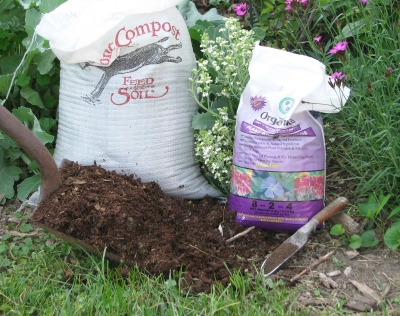
(Except in very acidic soils, other soil microbes then go on to convert ammonium nitrogen to nitrate nitrogen. This reaction screeches almost to a standstill at temperatures below 50 degrees Fahrenheit, so the ammonium nitrogen can just sit there, clinging to soil particles, until roots reawaken in late winter or early spring.)
Common sources of organic nitrogen include soybean meal, cottonseed meal, fish meal, and manure. Hoof and horn meal, leather dust, feather dust, and hair are esoteric sources, though plants will make use of them as if they were just ordinary, organic fertilizers. Even organic mulches, such as wood chips, straw, and leaves, will nourish the ground as they decompose over time.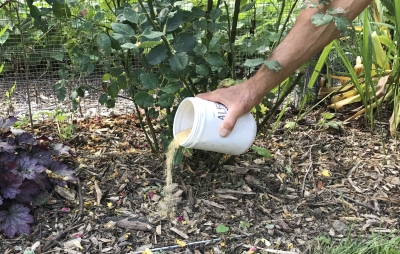
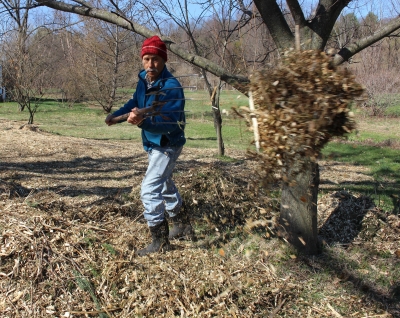
The Cadillac of fertilizers is compost. Compost offers a slew of nutrients, in addition to nitrogen, released slowly into the soil as microbes work away on it. Compost — most organic fertilizers, in fact — are not the ticket for a starving plant that needs a quick fix of food.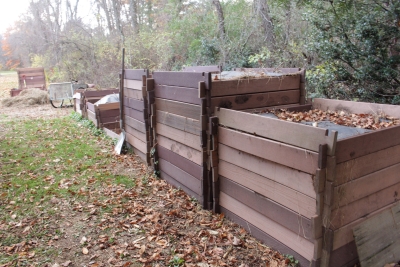
Every year I spread compost an inch deep beneath especially hungry plants like vegetables and young trees and shrubs to keep them well fed. Less hungry plants get one of the above-mentioned organic mulches. The benefits of these applications continue, trailing off, for a few years, so annual applications build up continual reserves of soil nutrients, doled out by soil microbes, that translate to healthy plants and soil.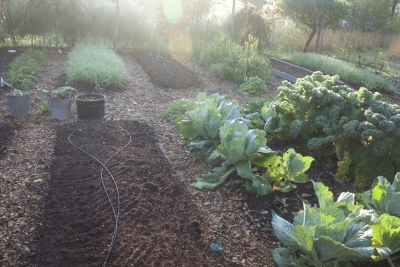
(More details about fertilization can be found in my book Weedless Gardening.)

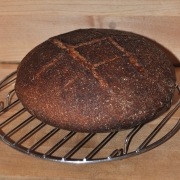

I was wondering about an application of biochar to help hold the nitrogen available for the plants thru the winter
I prefer to hold nitrogen with a soil rich in organic matter. I am not a big fan of biochar. Use the “search” feature on my blog to find a few posts I wrote about biochar, including the reasons I don’t use it.
Could I use Miko granite?
Darn auto fill.
Milorganite
The product from Milwaukee.
Thanks
Yes, you could use Milorganite, but apply it according to directions because it’s higher in nitrogen than most composts.
I’m interested in fertilizer.
That was a great article. Good clear explanation of nitrogen. Just the right amount of information.
Thanks.
Lee, years ago you suggested I fertilize my blueberry bushes in the autumn with soybean meal and I have been doing so, to excellent results. This year I planted several other fruit trees; peaches, pears, apples, gooseberries..do you suggest soybean meal would be beneficial to them as well? I also have 8 year old pawpaw trees (that for the first time are all are producing fruit), would they benefit from soybean meal? Can you suggest the quantity of soybean meal I should apply to these various fruit trees?
I prefer to use compost rather than soybean meal because of the many other benefits compost offers. Where an extra boost of soybean meal is needed, I use it at the rate of 1-2 pounds per hundred square foot spread of roots.
One of the images in this post shows you pouring meal right on top of wood chips. Is that right? You can apply them right on top?
Yes.
Thanks for the break down on fall fertilizing. Pun intended!
Very interesting. I always wondered whether or not to fertilize (in my case it would be compost) in the Fall. But still unclear exactly (or approxiamately) when to do –
September, October, November? Zone 4a (Canada)
If it’s only compost you are using, timing is immaterial unless you’re plants are starving, in which case the compost iwould be best applied months before plants needed the nutrients. Regular additions of ocmpost build up nutrient reserves in the soil that do not leach readily.
I live in the Pacific Northwest Canada zone 8 most soil here is acidic from winter rain but we had a very serious draught this past summer and many gardens suffered through a heat dome.
I buy bagged compost. Do all perennial beds, bushes and trees need nitrogen in the fall? I also have two raised beds for veggies. It was suggested to plant a green cover crop over the winter. Do I mulch over that cover crop? I’m thinking Rye grass.
Would alfalfa meal work on my blueberry bushes ?
Depending on the fertility of your ground, past soil management, and what you are growing, nitrogen specifically may or may not be needed. As I wrote inthe post, compost does offer nitrogen (and a lot of other goodies). Generally, my vegetables get all they need as far a nitrogen and other nutrients, from a one inch annual dressing of compost. Flower beds and some mature fruit trees are not as nitrogen-hungry, so get only an organic mulch.
As far as cover crops, rye GRAIN, different from rye GRASS, would be better. But it generally needs to be tilled in in spring. I don’t till, so plant oats, which winterkills here (but probably not in zone 8).
Is Comfrey Tea ammonium nitrogen? I have this “tea”in a trash can that I have been steeping for several months. Will need to dump it somewhere before there’s a deep freeze so the trash can doesn’t crack.
Correct me if I am wrong but I’ll assume comfrey leaves are ammonium nitrogen.
Yes, the nitrogen in comfrey tea is probably mostly ammonium nitrogen. The conversion of ammonium to nitrate requires oxygen. Don’t dump it all in one place; spread it out.
I found this resource to be an excellent guide for anyone looking to understand the basics of fertilizing their plants effectively. The author’s expertise shines through in their clear explanations and practical tips. I appreciated the emphasis on organic fertilizers and the environmentally friendly approach they promote. The step-by-step instructions for calculating fertilizer ratios and understanding nutrient requirements make it easier for readers to make informed choices. Overall, this article is a valuable resource for gardeners seeking to enhance their knowledge and achieve healthier, more vibrant plants.
Thanks for helping me understand that the soil should not be waterlogged when we are going cultivated plants. I want to know more about these things with the help of experts, especially when we are planning to buy solid products this weekend. With the right guidance, we can be sure that the backyard garden we wanted will be growing the plants successfully depending on what we actually want to have.